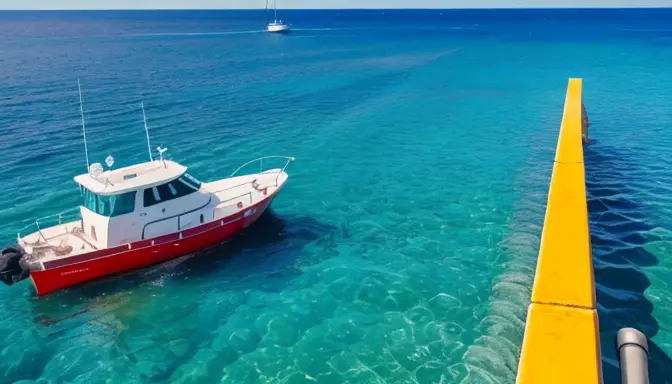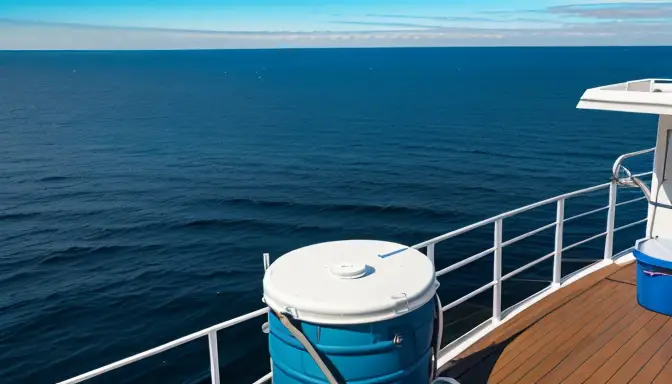Emptying your holding tank at sea is a crucial task that requires careful attention to detail and adherence to regulations. To ensure a smooth and environmentally friendly process, follow this step-by-step guide:
- Understanding Holding Tank Regulations: Familiarize yourself with the legal requirements and restrictions for emptying holding tanks at sea, including international regulations and best practices for compliance.
- Preparation and Safety Measures: Take the necessary steps and safety precautions before emptying your holding tank, such as securing equipment and preparing the vessel for the task.
- Locating the Pump-Out Station: Discover how to find and approach pump-out stations while at sea, ensuring proper waste disposal by navigating to the nearest facility.
- Connecting the Pump-Out Hose: Follow step-by-step instructions on how to securely connect the pump-out hose to your boat’s holding tank for leak-free waste removal.
- Emptying the Holding Tank: Learn efficient techniques for emptying the holding tank at sea while minimizing environmental impact.
- Cleaning and Disinfecting: Understand the importance of cleaning and disinfecting the holding tank and equipment after use to maintain hygiene and prevent odors on board.
- Record-Keeping and Compliance: Keep accurate records of holding tank emptying activities to stay compliant with regulations and demonstrate proper waste disposal practices.
- Environmental Responsibility: Explore the significance of environmental responsibility in emptying holding tanks at sea, including tips for reducing pollution and protecting marine ecosystems.
Understanding Holding Tank Regulations
When it comes to understanding holding tank regulations, it’s crucial to be well-informed about the legal requirements and restrictions that govern the emptying of holding tanks at sea. By staying compliant with international regulations and following best practices, boaters can contribute to environmental protection and ensure proper waste disposal.
Here are some key points to consider:
- Familiarize yourself with the specific regulations that apply to holding tank emptying in your region.
- Ensure that your vessel meets all the necessary standards and requirements for holding tank operations.
- Keep abreast of any updates or changes to regulations to avoid non-compliance issues.
By adhering to holding tank regulations, boaters can play a vital role in preserving the marine environment and safeguarding the waters for future generations.

Preparation and Safety Measures
When it comes to preparing to empty your boat’s holding tank at sea, are paramount. Ensuring you are equipped with the necessary tools and knowledge can make the process smoother and more efficient. Here are some key steps to consider:
- Secure Equipment: Before setting out, double-check that you have all the required equipment on board, including the pump-out hose and any protective gear.
- Vessel Preparation: Make sure your vessel is stable and properly anchored before attempting to empty the holding tank to prevent accidents or spills.
- Crew Briefing: Communicate with your crew members about the procedure and assign specific roles to ensure everyone is aware of safety protocols.
- Emergency Plan: Have an emergency plan in place in case of unexpected events, such as leaks or equipment malfunctions, to respond promptly and effectively.
By taking these seriously, you can minimize risks and ensure a safe and successful holding tank emptying process while at sea.
Locating the Pump-Out Station
When it comes to locating the pump-out station while at sea, it’s crucial to be prepared and informed. Here are some essential steps to help you find and approach the pump-out station efficiently:
- Consult your nautical charts or GPS system to identify the nearest pump-out station.
- Look for visual markers such as buoys or signs that indicate the location of the facility.
- Use marine radio channels to ask for directions or information from other boaters or authorities.
- Consider the wind and current conditions to plan your approach to the pump-out station safely.
Remember, proper navigation and awareness of your surroundings are key to successfully locating the pump-out station and ensuring responsible waste disposal at sea.

Connecting the Pump-Out Hose
When it comes to connecting the pump-out hose to your boat’s holding tank, precision and care are crucial. Follow these step-by-step instructions to ensure a secure and leak-free connection:
- Step 1: Locate the pump-out fitting on your boat, usually found on the deck or near the waterline.
- Step 2: Remove the cap from the pump-out fitting and set it aside in a safe place.
- Step 3: Inspect the pump-out hose for any signs of damage or wear that could cause leaks.
- Step 4: Align the threads of the pump-out hose with the fitting on your boat and twist it into place clockwise.
- Step 5: Tighten the connection by hand to ensure a secure seal, but be careful not to over-tighten and risk damaging the threads.
- Step 6: Once the hose is securely attached, double-check the connection for any visible gaps or leaks.
Emptying the Holding Tank
When it comes to emptying the holding tank on your boat while at sea, it’s essential to follow the proper steps to ensure a smooth and environmentally friendly process. Here are some key points to consider:
- Check Tank Levels: Before starting the emptying process, check the levels of waste in your holding tank to determine the amount that needs to be removed.
- Secure the Boat: Make sure your boat is securely anchored or stabilized to prevent any rocking or movement that could disrupt the emptying process.
- Follow Safety Guidelines: Wear appropriate protective gear, such as gloves and goggles, when handling the pump-out equipment to protect yourself from any potential hazards.
- Open the Tank Valve: Carefully open the valve on your holding tank to start the flow of waste through the pump-out hose.
- Monitor the Process: Keep an eye on the tank levels and the flow of waste to ensure that the emptying process is going smoothly and efficiently.

Cleaning and Disinfecting
When it comes to your boat’s holding tank after emptying it at sea, it’s crucial to maintain proper hygiene and prevent unpleasant odors on board. By following the right steps, you can ensure a clean and sanitary environment for yourself and your passengers.
Here are some key tips for effectively cleaning and disinfecting your holding tank and pump-out equipment:
- Use a marine-grade disinfectant to thoroughly clean the tank and equipment.
- Scrub all surfaces inside the tank to remove any residue or buildup.
- Rinse the tank and equipment with clean water to remove any remaining disinfectant.
- Allow the tank and equipment to dry completely before sealing them back up.
By following these guidelines, you can maintain a clean and odor-free environment on your boat while also ensuring the longevity of your holding tank and equipment.
Record-Keeping and Compliance
When it comes to for emptying your boat’s holding tank at sea, meticulous attention to detail is crucial. By maintaining accurate records of your holding tank emptying activities, you not only ensure compliance with regulations but also contribute to the protection of the marine environment. Here are some key points to consider:
- Documentation: Keep a detailed log of each holding tank emptying, noting the date, time, location, and volume of waste discharged.
- Regulatory Compliance: Familiarize yourself with the specific regulations governing holding tank discharge in the waters you are navigating.
- Proof of Compliance: Retain all documentation as proof of compliance in case of inspection or audit.
- Environmental Impact: Consider the environmental impact of your actions and strive to minimize pollution through responsible waste disposal practices.
Remember, staying on top of record-keeping and compliance not only protects the marine environment but also ensures the sustainability of your boating activities in the long run.

Environmental Responsibility
When it comes to emptying your boat’s holding tank at sea, should be at the forefront of your mind. It’s crucial to understand the impact that improper waste disposal can have on marine ecosystems and water quality. By following best practices and taking proactive steps, you can minimize pollution and protect the environment for future generations.
One way to demonstrate environmental responsibility is by reducing pollution through proper waste management. This includes using designated pump-out stations and following regulations for waste disposal. By avoiding the release of untreated sewage into the water, you can help maintain the health and cleanliness of our oceans and waterways.
Another important aspect of environmental responsibility is protecting marine ecosystems. By emptying your holding tank properly, you can prevent harmful chemicals and bacteria from contaminating the water and harming marine life. Taking care to minimize your impact on the environment can make a significant difference in preserving the delicate balance of marine ecosystems.
It’s also essential to educate yourself and others on the importance of environmental responsibility when it comes to boating and waste disposal. By spreading awareness and sharing best practices, you can help create a culture of sustainability and conservation within the boating community.
Frequently Asked Questions
- Is it legal to empty holding tanks at sea?
Emptying holding tanks at sea is subject to regulations that vary by location. It is important to familiarize yourself with the specific rules in the area where you are boating to ensure compliance with environmental laws.
- How often should I clean and disinfect my holding tank?
Regular cleaning and disinfection of holding tanks are essential to maintain hygiene and prevent odors. It is recommended to clean the tank after each use and perform a thorough disinfection at least once a month.
- What should I do if I encounter a problem while emptying the holding tank?
If you encounter any issues during the emptying process, such as leaks or blockages, it is best to stop the operation immediately and assess the situation. Seek professional assistance if needed to avoid any further complications.
- What Happened to Bluewater Yachts? The Inside Story - May 31, 2024
- Upgrade Your Boat’s Water Pump to the Mach 5 - May 30, 2024
- Upgrade Your Boat with the Big Stuff Stuffing Box - May 30, 2024


